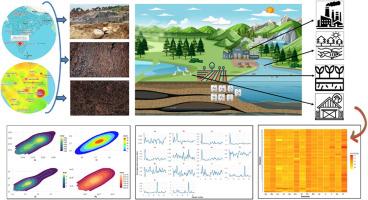Integrated assessment of heavy metal contamination and human health risks in granitic soils of South India: A multi-index approach to pollution and ecological impacts
引用次数: 0
Abstract
Granitic soils in South India are increasingly vulnerable to heavy metal contamination arising from both natural (geogenic) and human-induced (anthropogenic) sources, posing ecological and human health hazards. This study aimed to assess the concentration, spatial distribution, and potential risks of 14 heavy metals (HMs)—As, Ba, Co, Cr, Cu, Mo, Ni, Pb, Rb, Sr, V, Y, Zn, and Zr—in 44 soil samples collected from granitic terrains across the region. X-ray fluorescence (XRF) analysis was conducted on powdered samples to determine metal concentrations. Multiple indices, including Geo-accumulation Index (I_geo), Contamination Factor (CF), Modified Pollution Index (MFPI), and Pollution Load Index (PLI), were applied to evaluate contamination levels. Ecological risks were quantified using the Potential Ecological Risk Index (PERI) and toxicity units. Sample S27 exhibited the highest PERI value (6.001756), primarily due to elevated Zn levels. Zinc (Zn) and Zirconium (Zr) were identified as major pollutants with strong anthropogenic signatures. As presented, the lowest ecological toxicity (0.189 ± 0.059). Human health risk assessments revealed dermal contact as the primary exposure pathway for both non-carcinogenic and carcinogenic effects, particularly for Zn, Cr, and Co. Ingestion and inhalation pathways posed relatively lower risks, with Cr_ingestion and Cr_inhalation averaging 0.041 ± 0.038 and 0.166 ± 0.051, respectively. Spatial analysis highlighted localized pollution hotspots. Overall, integrated pollution indices indicated moderate contamination, with areas of severe localized impact. This study emphasizes the urgent need for pollution mitigation strategies in granitic regions of South India, especially targeting Zn and Zr contamination and addressing dermal exposure pathways in human health risk management.

南印度花岗岩土壤重金属污染和人类健康风险综合评估:污染和生态影响的多指数方法
南印度的花岗岩土壤越来越容易受到来自自然(地质)和人为(人为)来源的重金属污染,对生态和人类健康构成危害。摘要本研究旨在评估14种重金属(as、Ba、Co、Cr、Cu、Mo、Ni、Pb、Rb、Sr、V、Y、Zn和zr)在华北地区花岗岩地形44个土壤样品中的浓度、空间分布和潜在风险。对粉末样品进行x射线荧光(XRF)分析,测定金属浓度。采用地质累积指数(I_geo)、污染因子(CF)、修正污染指数(MFPI)和污染负荷指数(PLI)等评价污染水平。采用潜在生态风险指数(PERI)和毒性单位对生态风险进行量化。样品S27表现出最高的PERI值(6.001756),主要是由于锌水平升高。锌(Zn)和锆(Zr)被确定为具有强烈人为特征的主要污染物。生态毒性最低(0.189±0.059)。人体健康风险评估显示,皮肤接触是非致癌性和致癌性的主要暴露途径,尤其是Zn、Cr和Co。摄入和吸入途径的风险相对较低,cr_摄入和cr_吸入的平均值分别为0.041±0.038和0.166±0.051。空间分析突出局部污染热点。总体而言,综合污染指数表明污染程度中等,局部影响严重。本研究强调迫切需要在南印度花岗岩地区制定污染缓解战略,特别是针对锌和锆污染,并解决人类健康风险管理中的皮肤暴露途径。
本文章由计算机程序翻译,如有差异,请以英文原文为准。
求助全文
约1分钟内获得全文
求助全文

 求助内容:
求助内容: 应助结果提醒方式:
应助结果提醒方式:


